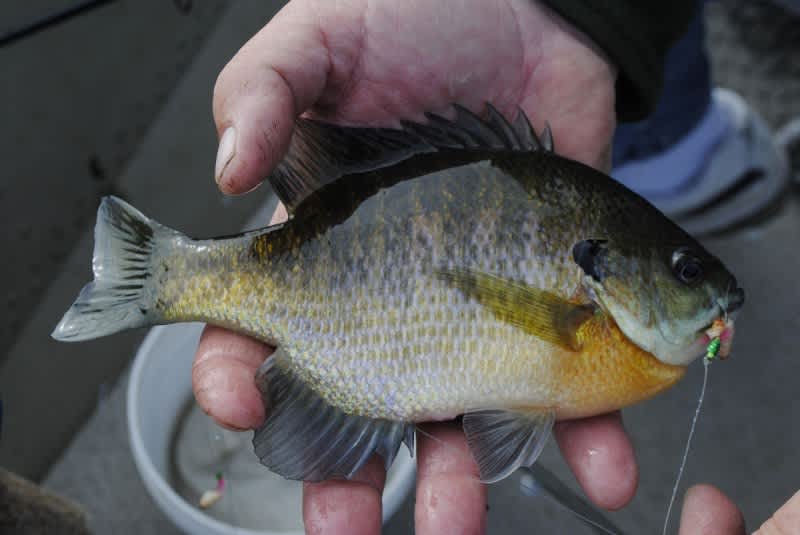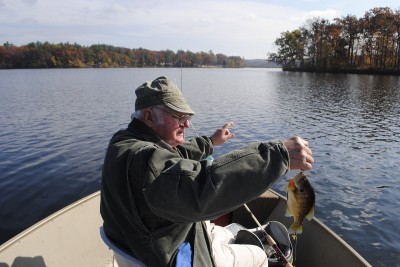Autumn Bluegills Biting in Western Michigan
Bob Gwizdz 11.19.14

John Hojnacki made a name for himself as a steelhead angler. But when the 57-year-old grocery store produce manager called the other day, he was all excited about something completely different: bluegills.
“It’s stupid good,” Hojnacki said. “We went out there other day at one o’clock (p.m.) and were done in an hour with a limit.”
I challenged him to show me. He did. So I wound up on a Western Michigan reservoir (he didn’t want me to say which one because, he said, he didn’t want “700 boats out there” the next time he goes and besides, it doesn’t matter, they’re everywhere) with the Hoje and a couple of his fishing buddies (Rex Baker and Fred Smith) on a frosty morning recently.
And it wasn’t how it had been. It took us a while. But at two different points we were “windmilling them,” as Hojo puts it.
“This is good year-round,” Hojo said. “There are peaks and valleys, but if you stay on them, you follow them around, you’ll get them. It gets nothing but better until ice up, but how can it get any better than 50 in an hour?”
Good question.
We went to about 35 feet of water, dropped anchor, and started fishing. Hojo and I each caught a pair of fish—one of my mine was a throwback, both of Hojo’s were good ones—but the other guys weren’t getting bit so we moved.
And moved and moved and moved. At about our sixth or seventh stop, we suddenly hit a bunch of fish and we put 20 of them in the boat just like that. When they quit, we moved again.
We didn’t have any electronics on the boat, so we couldn’t look for fish or structure elements, though Hojo insisted there wasn’t any structure to look for.
“It’ a big flat,” he said. “They’re coming from the deep water and feeding on the flats. You can feel them—they’re ice cold.”
Hojo fishes with long limber rods—10-foot, 5-weight fly rods—equipped with spinning reels. He had braided line on his reels—I had monofilament on my mine—but it didn’t matter, Hojo said, because the key was in our rigs.

We were using Ron Springs Pan Fish Rigs (most would consider them perch rigs) with tiny jigs tied on three-inch droppers off a main line of 10-pound test fluorocarbon.
“You use fluorocarbon so you don’t have to use real light mono,” Hojo said. “You’ve got to run stiffer line so it isn’t twisting all around. You can run 10-pound flouro and it’s like four-pound mono but it’s not twisting all around.”
We tipped our jigs with wax worms, but it could have been wigglers, mousies, tiny minnows, red worms—even Gulp, Hojo said. Some days one bait outshines the others, but often it doesn’t matter, he said.
One key, Hojo said, is to use a heavy sinker.
“I use a one-ounce sinker,” he explained. “You’re fishing mostly the 30- to 35-foot range so you get down there in an instant and you’re in the zone right away. Sometimes when you’ve got little fish suspended up above and you’ve got a light sinker, they’re whacking at the bait on the way down, either pulling the bait off or you’re catching them. So zoom through them get to the bottom quick.
“If you’re as good a fisherman and I am, I’m going to out-fish you two to one if you’re using a light weight because I get it down there so fast. I’m down there and back up with a fish before you can get down.”
The heavy weight also sinks into the mud on the bottom, Hojo said, keeping you in the strike zone and your line taut.
“It’s like a bow string, tight,” he said. “The fish aren’t giving you four days to set the hook. They can suck it in and spit it out before you know it. If they barely touch it, you set the hook. Something swims by it and you know it.”
Hojo fishes two rods and is often pulling a fish off one while another is biting the other.
“Fred and I had six on the other day at one time—we both caught a double on one rod and a single on the other.”
Anglers make two mistakes when fishing this way, Hojo said. They use wire spreaders instead of fluorocarbon line (“Those fish can see those things,” he said, “no doubt about it”) and they don’t fish deep enough water.
“The big fish are deep,” he said. “Just like pike or anything else. They’re on the bottom. There’s worms and bugs and grubs down there and they’re rooting around in that muck, getting them.
“What’s so sweet about it is it’s simple. The rig’s a killer. It’s not that complicated. What’s the big deal?”
About 1 p.m. we got on the motherlode. All four of us were catching them one after another, fat eight-inch (some bigger, few smaller) ‘gills. At 2 p.m., while they were still biting, Hojo said he had to go. We had 90 fish. Could we have caught 10 more? What do you think? I had more than I wanted to clean, anyway.
“On a work-hard day it takes four or five hours to get your fish, but when they’re on. It doesn’t take a superstar to catch them. They’re just bluegills.”
For more information on Michigan fishing go to michigan.org. Click here to purchase a Michigan fishing license online.
This article was produced in partnership with Pure Michigan.

